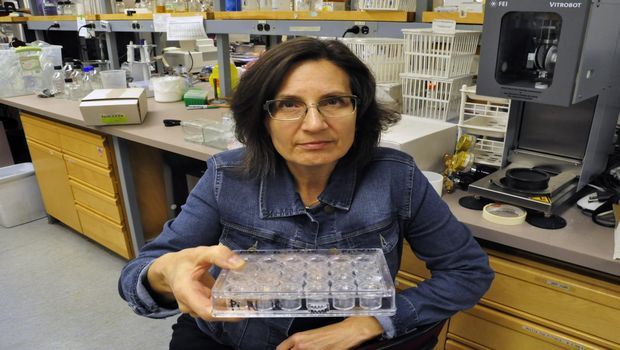Understanding How the Blood-Brain Barrier is Breached in Bacterial Meningitis
Simon Fraser University researcher Lisa Craig is part of an international team that has uncovered new details about a microbe that invades the brain, sometimes with fatal results. The information is a critical piece of the meningitis puzzle, and could lead to new ways of treating meningococcal infection. The research was published today in the journal Nature Communications.


Simon Fraser University professor Lisa Craig is part of an international research team that has revealed the most detailed structure to date for a Type IV pilus. Courtesy of SFU
Simon Fraser University researcher Lisa Craig is part of an international team that has uncovered new details about a microbe that invades the brain, sometimes with fatal results. The information is a critical piece of the meningitis puzzle, and could lead to new ways of treating meningococcal infection. The research was published today in the journal Nature Communications.
Craig, a professor in SFU's Department of Molecular Biology and Biochemistry, and SFU research associate Subramania Kolappan, have worked with researchers at the Institut Necker Enfants Malades in Paris and the University of Virginia School of Medicine to reveal the most detailed structure to date for a "Type IV pilus". These pili are long, thin filaments that extend from a bacterial surface.
The research has important implications for the bacterium Neisseria meningitides, which causes meningitis. This bacterium is present in the nasal passages of about 10 per cent of healthy adults, but occasionally escapes and enters the bloodstream.
There, its Type IV pili interact with molecules on cells lining the tiny blood vessels that supply oxygen to the brain.
"Normally, the tight association of these endothelial cells prevents bacteria from passing across the blood vessel walls," says Craig. "This network of blood vessels is called the blood-brain barrier."
The binding of Type IV pili disrupts the tight packing of these cells. This permits the bacteria to slip between the cells and gain access to the space between the brain and its surrounding membranes.
There, the bacteria induce an inflammatory response that leads to an accumulation of fluids (meningitis). This puts pressure on the brain and results can be fatal.
Using x-ray crystallography, cryo-electron microscopy and three-dimensional image reconstruction, the researchers revealed, for the first time, a detailed molecular structure of the N. meningitidis Type IV pilus. This gives scientists a glimpse into how this microbe can bind to, and disrupt, endothelial cell junctions in order to breach the blood-brain barrier.
The pilus structure further revealed a conformational change that occurs when the pilin sub-units becomes incorporated into the pilus.
"This helps us to understand the structure, function and assembly of Type IV pili, which are present on many bacterial pathogens," says Craig.
"It's a critical piece of the meningitis puzzle, and may help researchers to develop drugs to interfere with N. meningitidis interactions with the epithelium, in order to prevent and treat meningococcal infection."
She says the findings may also lead to therapies that deliberately open the blood-brain barrier to administer drugs for treating non-bacterial brain diseases.
The main funding for this research is from the Canadian Institutes of Health Research (CIHR).
Source: Simon Fraser University
Show, Tell, Teach: Elevating EVS Training Through Cognitive Science and Performance Coaching
April 25th 2025Training EVS workers for hygiene excellence demands more than manuals—it requires active engagement, motor skills coaching, and teach-back techniques to reduce HAIs and improve patient outcomes.
The Rise of Disposable Products in Health Care Cleaning and Linens
April 25th 2025Health care-associated infections are driving a shift toward disposable microfiber cloths, mop pads, and curtains—offering infection prevention, regulatory compliance, and operational efficiency in one-time-use solutions.
Phage Therapy’s Future: Tackling Antimicrobial Resistance With Precision Viruses
April 24th 2025Bacteriophage therapy presents a promising alternative to antibiotics, especially as antimicrobial resistance continues to increase. Dr. Ran Nir-Paz discusses its potential, challenges, and future applications in this technology.